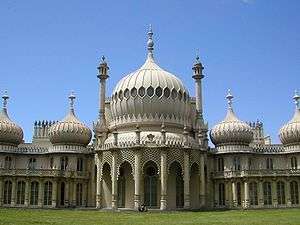Ammonite order

Ammonite capitals on a house in Oriental Place, Brighton
The Ammonite order is an architectural order that features fluted columns and capitals with volutes shaped to resemble fossil ammonites.[1] The style was invented by George Dance and first used on John Boydell's Shakespeare Gallery in Pall Mall, London in 1789 (later the British Institution; demolished in 1868).
Ammonite motifs were also used on buildings in Old Regent Street, London, probably by John Nash from around 1818 (demolished in the 1920s).
Architect, geologist and fossil collector Amon Wilds used the Ammonite order on the façade of his house in Castle Place in Lewes, probably as a punning reference to his forename. His architect son, Amon Henry Wilds, also used the order on several early 19th century terraces in Brighton.
See also
References
- ↑ Dziekan, Vince (2012). Virtuality and the Art of Exhibition: Curatorial Design for the Multimedial Museum. Intellect Books. p. 178. ISBN 9781841504766. Retrieved 2 August 2016.
External links
- http://www.fownc.org/newsletters/no52.shtml
- http://www.nhm.ac.uk/nature-online/earth/fossils/fossil-folklore/themes/decoration04.htm
This article is issued from Wikipedia - version of the 8/6/2016. The text is available under the Creative Commons Attribution/Share Alike but additional terms may apply for the media files.

.jpg)
.jpg)
